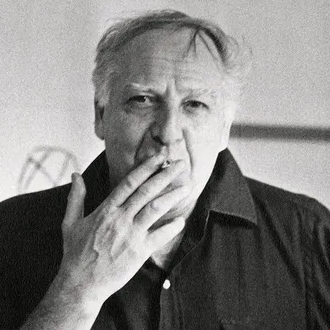
Philip Guston
Philip Guston, a Canadian-born American artist, was renowned for his playful integration of abstract elements into figurative scenes. He gained recognition for his work in two seemingly distinct yet interconnected styles: Abstract Expressionism and Representational Painting.
Biography of Philip Guston
Born in Montreal, Canada as Philip Goldstein, the artist's family moved to Los Angeles in 1919, when he was still a child. In 1923, Guston's father tragically hanged himself, and Philip found his body.
Four years later, Guston started painting after enrolling in Los Angeles Manual Arts High School, where he met Jackson Pollock. They were both expelled for openly criticizing school policies. In 1930, Guston received a scholarship to Otis Art Institute in Los Angeles, where he met his future wife, artist and poet Musa McKim. Dissatisfied with the school's emphasis on painting from plaster casts instead of live models, Guston left, becoming largely self-taught.
In the mid-1930s, he adopted the surname Guston. From 1930, he created politically aware murals, including one in Mexico, influenced by David Siqueiros. In the winter of 1935, Pollock persuaded Guston to move to New York permanently, where he met many New York School painters. Guston continued painting murals until around 1942, but from 1940 onwards, his work increasingly embraced elements of abstraction, realism, and mythic references, culminating in a unique and personal style.
Over time, Guston refined his signature color palette, featuring a wide range of tones within restricted hues, while the surfaces of his canvases gained texture. By 1950, he completed his first abstract works, gaining attention and acclaim.
Following his 1966 Jewish Museum survey, a period of personal turmoil and inner conflict engulfed Guston. He completely abandoned painting for two years, turning his focus to drawing. During this time, he produced hundreds of works on paper using charcoal and brush-and-ink, now widely recognized as his 'pure' drawings.
By 1967, his frustration with abstraction had peaked, leading him back to a representational approach, this time in a personal and cartoonish style. The first exhibition of these new works in 1970 received harsh criticism from many art institutions. However, his former abstract colleague, Willem de Kooning, was among the few who immediately understood the significance of Guston's new direction, recognizing the paintings as expressions of freedom.
Despite being misunderstood by many, Guston retreated to Woodstock, continuing to develop this new style. Between 1969 and 1972, he created numerous paintings, now some of his most renowned. These existential and somber works eventually gained widespread popularity and acceptance.
The artist passed away in 1980 in Woodstock due to a massive heart attack. Shortly after his death, he was posthumously elected to the National Academy of Design as an Associate Academician.
Beyond his art, he was highly regarded for his academic career, teaching and personally influencing generations of young artists. Guston taught at the University of Iowa's School of Art and Art History from 1941 to 1945, then continued teaching at New York University and the Pratt Institute. Later in his career, he conducted a monthly graduate seminar at Boston University.
Years:
Born in 1913
Country:
Canada, Toronto